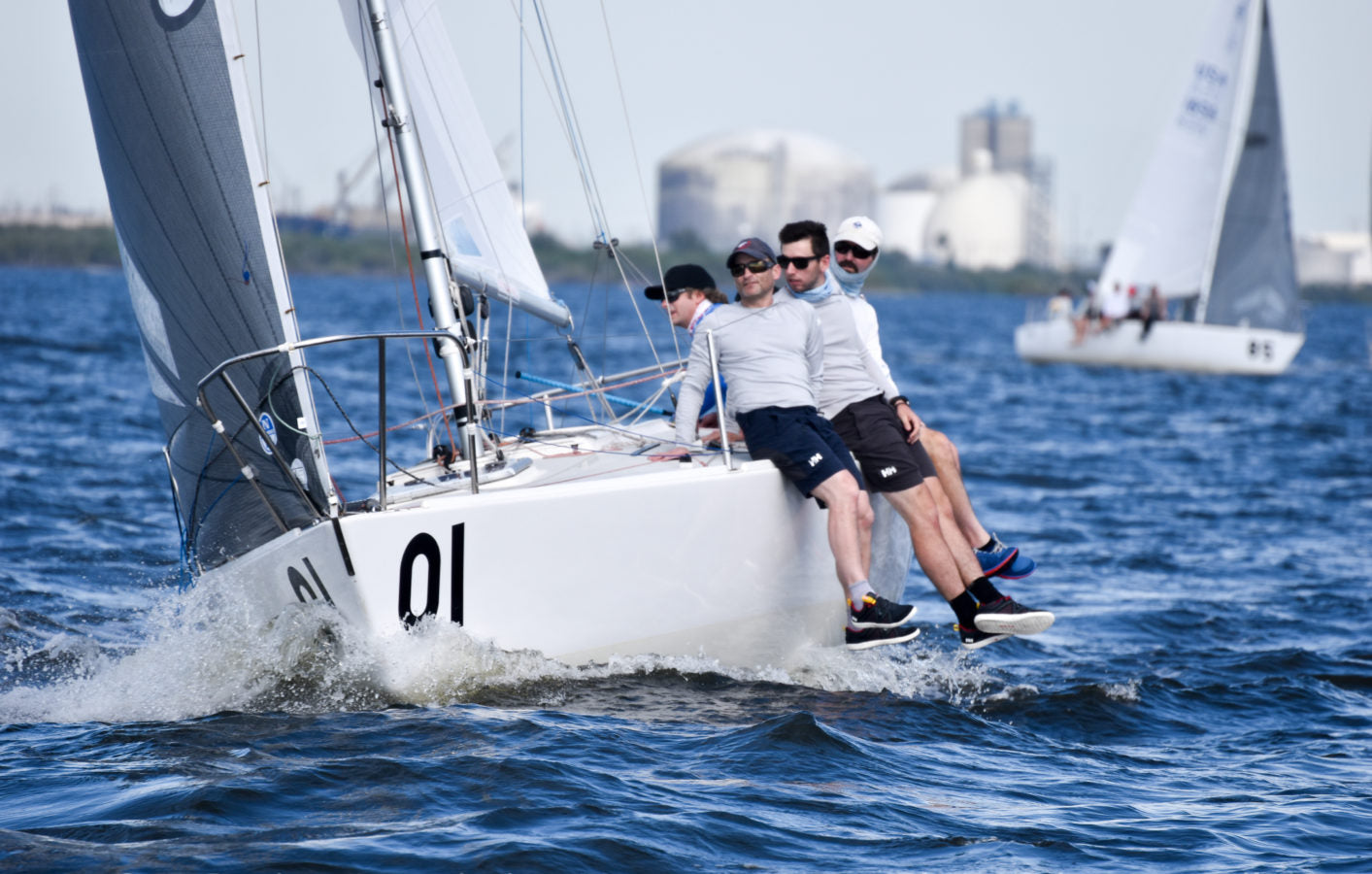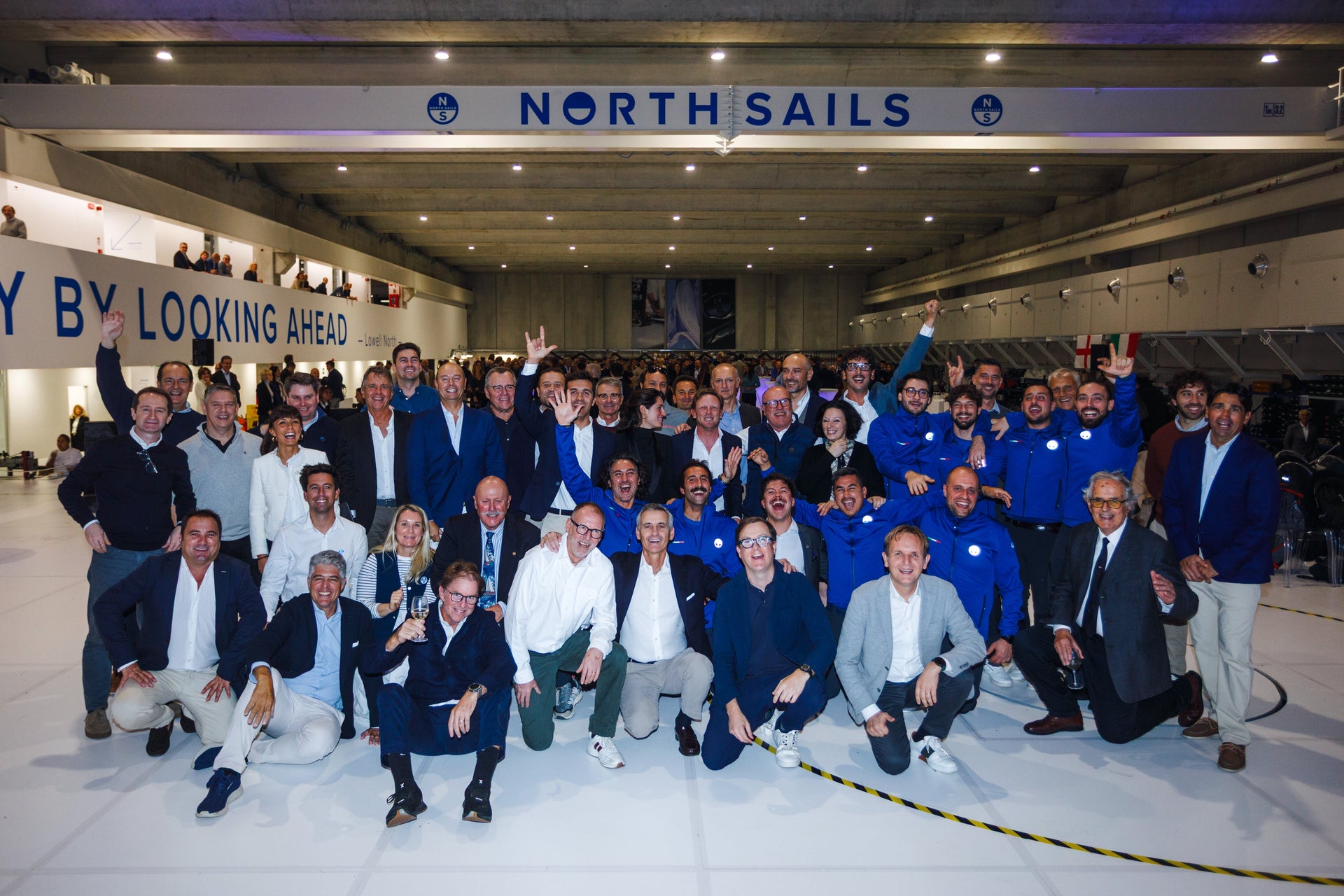STARTING, TACTICS, & SET UP
STARTING, TACTICS, AND SET UP
Strategies From the 2019 Midwinters In Tampa, FL

On the first two days of Midwinters in Tampa, the breeze built from a 5-8 knot SE to the ‘normal’ SW seabreeze. On the final day, the breeze filled first from the south and shifted southwest much sooner, eventually strengthening to 12-15 knots. Every day, the strategy remained the same.
Daily debriefs after sailing provided some great insights from sailors at the top of the fleet, including: North Sails Expert and J/24 World Champion Tim Healy, Hydra Sailing Solutions coach and Old Dominion All-American Marty Kullman, and Brown University Coach and Collegiate All-American John Mollicone. Marty was tactician for Bangor Packet. Tim Healy was tactician for New England Ropes. John Mollicone was Tim’s helmsman. Take notes!
Using your prostart properly
Q: When you tack onto starboard, how do you judge how far away from the line?
A: Time and distance using your Velocitek, ask yourself: how many meters- how many seconds?
Example: Your Velocitek reads 50 meters at 60 sec., so you are travelling at roughly two knots, which is actually pretty slow. When you are that slow, it’s hard to control the boat once you get on the line.
tip: You want to be a touch further away from the line so you’d be approaching at about one second per meter.
Q: How much time do I have to burn so I’m not over early?
A: It depends on what shift you are in at the start.
Main Point:
Get out there early and practice your accelerations, then distance and time from the line. This will help you figure out the best place to start accelerating and you can trust what the velocitek is telling you.

Q:How do you properly ping the line?
A: When you get your pings, you want to cross the starting line close hauled. Come in on starboard at the same angle you would be close hauled. That’s where your bow is on the line. Do the same at the pin. The far side is easiest for the bow guy.
tip: The slower the better when you do your pings. This is so you can do it the same every time and you can trust what the tool is telling you. When you get comfortable with that, one guy is in charge of meters, one is in charge of time, and you can figure out fast if you need to be coming up to the line faster.
Main point: Always come in on starboard/port at the right angle, your true close hauled course, so your ping is accurate. Do it the same every time. At some point you’ll develop a routine and it will all become easier each time. You’ll learn to trust what the velocitek is telling you.
Strategy at the start
After you get comfortable with all the prestart tasks you develop a routine. For a port approach you are looking for a place to tack at 1:30 or closer to 1:00
Think about it this way:
In the light air, when the wind goes left you are racing earlier, maybe even trying to make the pin end. When the wind goes right you are burning speed at the start, going head to wind more, keeping in mind that you can’t set up too early.
You really need to know what shift you are in. Right shift, starting on starboard, you are going to get to the line faster. Left shift? It will take longer for you to get there.
Main Point: Know what shift you are on before the start
Example: If you are 20 meters away from the line and get a 10 degree right shift there is less distance to cover to get to the line because you are now able to sail more perpendicular to the start line and will take less time to get there. In a 10 degree left shift, there will be more distance to sail to the line because you will be sailing much more parallel to the starting line and will take more time to actually get to the line. .
Tip: Your tactician needs to articulate to the skipper: “We need to get going, go quicker, it’s a left phase, etc.”

Prestart Sail Setup & Technique
Tip: Make sure your traveller is preset, even if you are on port at the time (port approach)
Don’t have a lot of backstay on, but you can preset if you need it (in windier conditions). Mainsheet and final genoa trim is all you need to focus on as skipper at the start.
Average Genoa Trim:
You want to go 3” off the spreader tip on average. Sometimes a little tighter or looser but 3” average. You can trim tighter when it feels right.
Main Point: Trimmer on final approach needs to be in sync with skipper to get up to speed. Make sure your main comes in tight, trim in, and how tight you trim in all depends on my lane off the line.
tip: Another thing that’s important is to make sure your mainsail is up all the way. We mark it so we can see if it slipped. It will always stretch the first time, so you gotta tighten it before the first race and between races.
At The Start
Q: Is there a boat to leeward of me off the start?
A: If there is, you need to put them away.
Foot over them at the start to get them out of the way early. This only applies to a threat to leeward. If your tactician tells you that you have to pinch off someone to windward that’s when you revert to high mode.
Ask yourself: Am I in height mode? If yes, you trim the main in hard. Then you can pinch off the guy to windward before he has the chance to roll me.
Your trim all depends on how much space to leeward you have. Should you climb or foot? Sailing higher is slower, but sometimes to pinch off the guy to windward you can get away with sailing your high mode to get rid of them.
Main Point: At the start, think about what mode you are in and get over-top the leeward boat ASAP

Strategy beyond the start
Local knowledge is great but you have to sail with what you see. On day one, we hedged right but the pressure was left. Day two you had to connect the pressure, but don’t spend time sailing to it in a header. Sail on the tack that’s pointing at the pressure if you can to get there quicker.
Q: Why is it important to go upwind early when you get to the race course?
A: So you get to know what’s happening. To get a good idea of the shifts that are happening, you have to give yourself time to sail upwind so you can figure it out. You have to go with what you feel and where the pressure is strong. Make sure your boat is set up correctly for speed.
Main point: You have to go with what you feel and see.
Q: When you are in the middle, and you feel light. What’s the next best step?
A: Be patient and get to an edge. Sail towards the pressure if you can, but get to an edge. Once you are at the edge, you want to make sure you are into the pressure all the way before you tack. If you are too shy of the pressure, you won’t get the full effect.

Technique off the line and on the beat
Q:If you are deep in the fleet, and you’re thinking about shifts vs. clear air, which do you choose and why?
A: You can’t be in bad air, you need to find a shift so you get out of there. The amount of air that twists off a J/24 sail is major. Sail in bad air for three minutes? NO, it’s better to do two tacks. There are times where you’ll have to hold out for a short time, but you don’t want to be in bad air for long. You need to maintain your boat speed as often as possible.
Example: It cost us five boat lengths in one race, but we double tacked because we could keep our speed. It was worth it.
Tip: As tactician, you ask the skipper, are you starting to feel it? Are you having a hard time? Then you have to tactically decide how to get out of there. Sometimes it can be worth sticking it out, but your skipper will tell you if they can hang on a bit longer. This can bide you some time if you are looking for a clear lane, but you can’t wait that long.
Main point: Your skipper will tell you if they are struggling. Then you can decide what the next best thing is.
Tip: The lighter it is the more bad air affects you. If you feel like you are getting affected, foot or tack away. Ask yourself: “Is it really painful worth tacking away? Or not so bad where you can hang a bit longer?”
Main point: You need to have a high mode. Yes high mode is slower, but, if you can sail fast in high mode you can stick out the situations where it’s necessary to wait for a lane to clear.












